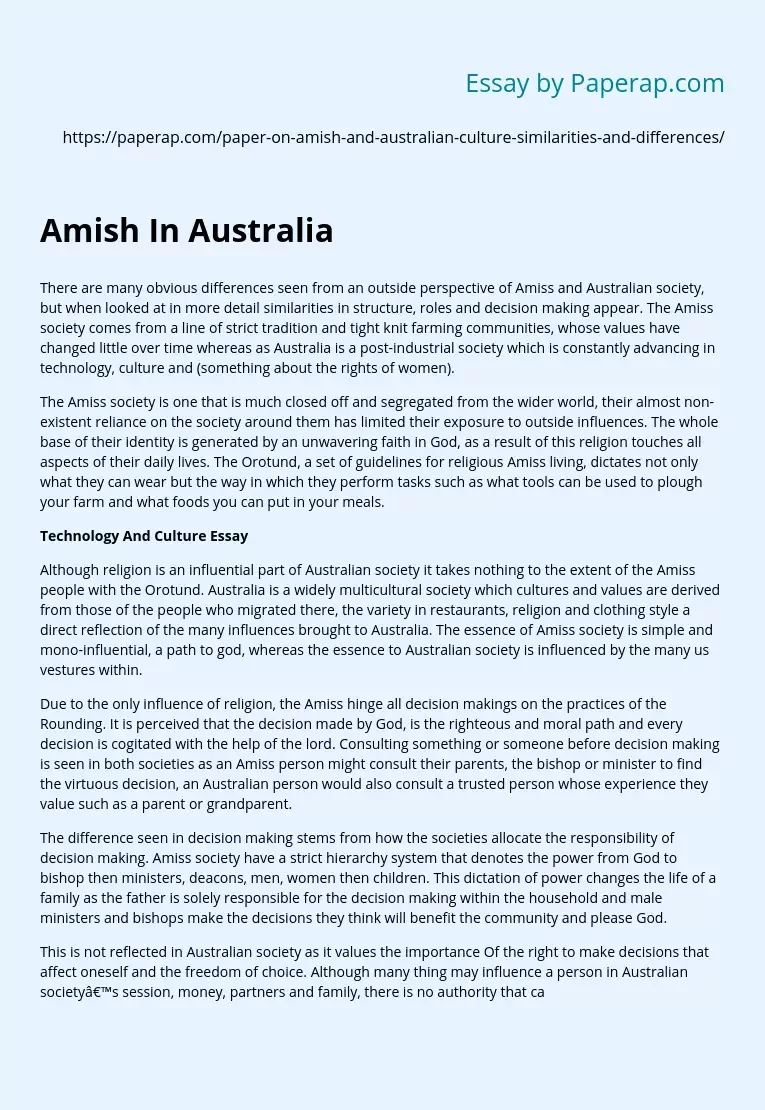There are many obvious differences seen from an outside perspective of Amiss and Australian society, but when looked at in more detail similarities in structure, roles and decision making appear. The Amiss society comes from a line of strict tradition and tight-knit farming communities, whose values have changed little over time whereas as Australia is a post-industrial society which is constantly advancing in technology, culture and (something about the rights of women).
The Amiss society is one that is much closed off and segregated from the wider world, their almost non-existent reliance on the society around them has limited their exposure to outside influences.
The whole base of their identity is generated by an unwavering faith in God, as a result of this religion touches all aspects of their daily lives. The Orotund, a set of guidelines for religious Amiss living, dictates not only what they can wear but the way in which they perform tasks such as what tools can be used to plow your farm and what foods you can put in your meals.
Although religion is an influential part of Australian society it takes nothing to the extent of the Amiss people with the Orotund. Australia is a widely multicultural society which cultures and values are derived from those of the people who migrated there, the variety in restaurants, religion and clothing style a direct reflection of the many influences brought to Australia. The essence of Amiss society is simple and mono-influential, a path to god, whereas the essence to Australian society is influenced by the many us vestures within.
Due to the only influence of religion, the Amiss hinge all decision makings on the practices of the Rounding. It is perceived that the decision made by God, is the righteous and moral path and every decision is cogitated with the help of the lord. Consulting something or someone before decision making is seen in both societies as an Amiss person might consult their parents, the bishop or minister to find the virtuous decision, an Australian person would also consult a trusted person whose experience they value such as a parent or grandparent.
The difference seen in decision-making stems from how the societies allocate the responsibility of decision making. Amiss society have a strict hierarchy system that denotes the power from God to bishop then ministers, deacons, men, women than children. This dictation of power changes the life of a family as the father is solely responsible for the decision making within the household and male ministers and bishops make the decisions they think will benefit the community and please God.
This is not reflected in Australian society as it values the importance Of the right to make decisions that affect oneself and the freedom of choice. Although many thing may influence a person in Australian society’s session, money, partners, and family, there is no authority that can make a decision for you, a husband doesn’t make decisions for a wife and the church doesn’t make a decision for you. This is seen as a critical necessity in Australian society, as liberation and rights are a value cherished by all but is not viewed as a fundamental value in Amiss society.
Authority in Amiss society also comes under the umbrella of religion, the Orotund dictates who has the power and authority and in what areas it can be exercised. Only men are allocated positions of power and there are no requirements for training Geiger education or theological training. This idea is not returned at all in Australian society, since the 1945 women’s right movement women in Australia have been gaining power not only in the home but in the workplace and the business world, and the liberation of women is seen as one of the proudest moments in Australian history for women.
Ministers and Bishops in Amiss society are nominated by members of the church and chosen in a process that incorporates divine intervention and do not require any training for these positions, this may be a result of the low level of conventional cooling as well as the prohibition on high school and college education. This however is thoroughly encouraged in Australian society as higher-level Of qualifications lead to generally higher regarded jobs and people are elected in positions of power based on their qualifications and appeal to the people.
Amiss society is based on humbleness and simplicity and believe power will lead to pride and the abuse of power and Australian is a more liberal society denoting power based on qualification and democracy. Power and Authority is closely linked to the roles in an Amiss society. Within the household a mans the breadwinner, in charge of decisions and daily running of the family within the rules of the Orotund. He and his sons run the business or the farm while the women cook, clean, and watch over small children during the day.
This is not unusual to the Australian household, up until the revolution of women’s rights the Amiss family structure mirrored that of an Australian family. Traditionally the Australian husband went out and provided for the family while the wife stayed home and catered to his needs. In modern Australia this is no longer custom, Australia has grown to a very anthropometry society with the rise of different home situations not seen in the Amiss community such as single parents and same-sex couples.
The roles have changed with many more women in the workplace and the slow acceptance of stay-at-home dads, it has become a choice made by each family and many variations are seen. When observed thoroughly in micro, mess and macro levels Amiss and Australian societies have fundamental similarities including historical gender role allocation and the influences for decision making.
Technology And Culture Essay. (2019, Dec 05). Retrieved from https://paperap.com/paper-on-amish-and-australian-culture-similarities-and-differences/

